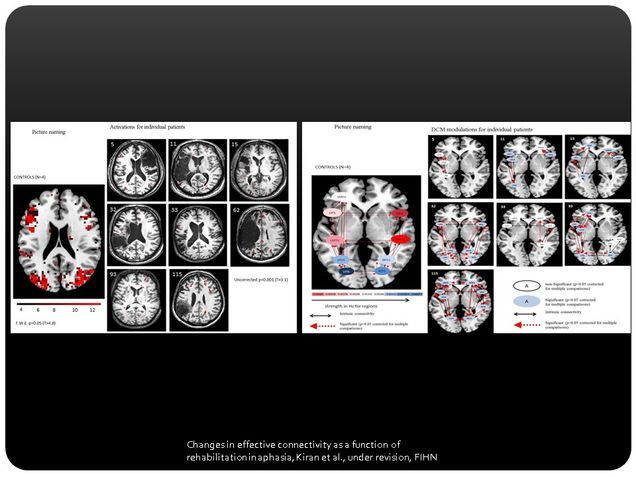Projects on Language Recovery Using fMRI
Neuroimaging of Language Recovery
We are now interested in examining whether behavioral language recovery observed in treated patients is correlated with underlying functional changes in the brain as a result of treatment. Hence, we have started functional neuroimaging (fMRI) experiments to investigate activation in brain regions in patients with aphasia before and after they receive treatment.
It is hoped that changes in activation that are observed in the brain scans will provide us with some understanding of how language is recovered in the damaged brain following treatment. This important data will contribute to the growing body of evidence supporting the notion of brain plasticity in adulthood and after brain damage.
Our work is part of a larger effort to examine the nature of language recovery after rehabilitation. Read about this work here.
We are part of the Center for Neurobiology of Language Recovery
Our publications in this area:
Meier, E. L., Kapse, K. J., & Kiran, S. (2016). The relationship between frontotemporal effective connectivity during picture naming, behavior, and preserved cortical tissue in chronic aphasia. Front. Hum. Neurosci., 10, 109. DOI: 10.3389/fnhum.2016.00109. http://journal.frontiersin.org/article/10.3389/fnhum.2016.00109/full
Sims, J., Kapse, K., Glynn, P., Sandberg, C., & Kiran, S. (2016). The relationships between the amount of spared tissue, percent signal change, and accuracy in semantic processing in aphasia. Neuropsychologia, 84, 113-126.
Sandberg, C., Bohland, J., & Kiran, S. (2015). Neural plasticity related to direct training and generalization effects of word finding treatment in chronic aphasia. Brain and Language. 150, 103-116.
Kiran S, Meier EL, Kapse KJ and Glynn PA (2015) Changes in task-based effective connectivity in language networks following rehabilitation in post-stroke patients with aphasia.Frontiers in Human Neuroscience. 9:316. doi: 10.3389/fnhum.2015.00316
Kiran, S., Ansaldo, A., Bastiaanse, R., Cherney, L. R., Howard, D., Faroqi-Shah, Y., Meinzer, M., & Thompson, C. K. (2013). Neuroimaging in aphasia treatment research: standards for establishing the effects of treatment. Neuroimage, 76, 428-435. doi: 10.1016/j.neuroimage.2012.10.011 PMC # 3552150.
Meinzer, M., Beeson, P., Cappa, S., Crinion, J., Kiran, S., Saur, D., Parrish, T., Crosson, B., Thompson, C. (2012). Neuroimaging in aphasia treatment research: Consensus and practical guidelines for data analysis. Neuroimage.
Sandberg, C., & Kiran, S. (2013). Analysis of abstract and concrete word processing in persons with aphasia and age-matched neurologically healthy adults using fMRI. Neurocase. doi: 10.1080/13554794.2013.770881NIHMSID # 451403
Kiran. S., (2012). What is the nature of post-stroke language recovery and reorganization? ISRN Neurology. doi:10.5402/2012/786872
Sebastian, R., Kiran, S., & Sandberg, C. (2012). Semantic processing in Spanish–English bilinguals with aphasia. Journal of Neurolinguistics, 25(4), 240-262. doi: 10.1016/j.jneuroling.2012.01.003
Sebastian, R. & Kiran, S. (2011). Task Modulated activation patterns in chronic stroke patients with aphasia. Aphasiology.25 (8), 927-951



